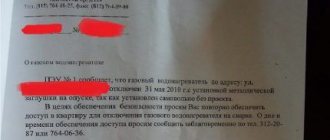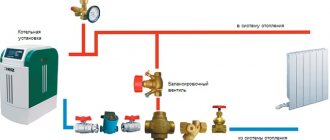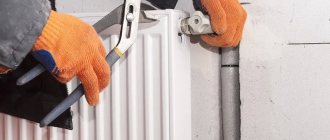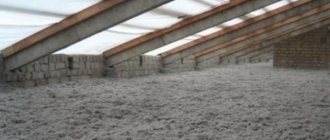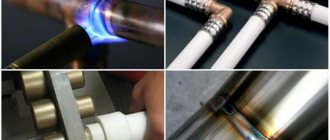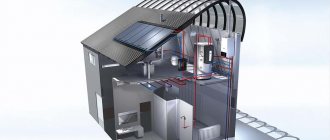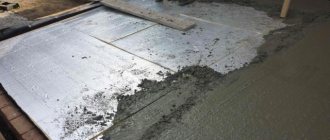Hot water supply in your own home has long become a necessary standard for providing household amenities. In a separate house it can be accomplished through the use of various water heating devices.
Nowadays, electric models are popular, they are produced in a wide range with different performance and operating principles. They are called “boiler”, they are made in the form of a sealed boiler with water as a coolant and work by heating it:
- direct method, when the heat source is built directly into the tank;
- indirect way: a coil is mounted inside the boiler, through which additional coolant circulates from a nearby boiler with burned biological fuel;
- combined when both options are used.
For most budget apartments, the easiest way is to connect a direct heating boiler, powered by electricity according to the storage principle: the water temperature inside the boiler is constantly maintained by automatic operation within user-specified limits.
Selecting a heating element
When choosing a heating element, you need to pay attention to some details. Only in this case can you count on a successful purchase, high-quality heating, long service life and compatibility of the selected model with a water heating tank, boiler or radiator
Shape and size
There are dozens of heating element models available for buyers to choose from. They have different shapes - straight, round, figure-eight or ear-shaped, double, triple and many others. When purchasing, you should focus on the use of the heater. For installation in sections of heating radiators, narrow and straight models are used, since there is quite little space inside
When assembling a storage water heater, you should pay attention to the volume and shape of the tank, and based on this, choose a suitable heating element. In principle, almost any model will fit here
If you need to replace a heating element in an existing water heater, you need to purchase an identical model - only in this case can you count on the fact that it will fit into the tank itself.
Power
If not everything, then a lot depends on power. For example, this could be the heating rate. If you are assembling a small-volume water heater, the recommended power will be 1.5 kW. The same heating element will be able to heat disproportionately large volumes, but it will do this for a very long time - with a power of 2 kW, heating 100-150 liters of water can take 3.5 - 4 hours (not to a boil, but on average by 40 degrees).
If you equip a water heater or water tank with a powerful 5-7 kW heating element, the water will heat up very quickly. But another problem will arise - the house electrical network will not withstand it. When the power of the connected equipment is above 2 kW, it is necessary to lay a separate line from the electrical panel.
Protection against corrosion and scale
When choosing heating elements for heating water with a thermostat, we recommend paying attention to modern models equipped with scale protection. Recently, models with enamel coating have begun to appear on the market.
It is this that protects the heaters from salt deposits. The warranty on such heating elements is 15 years. If you don’t find similar models in the store, then we recommend purchasing stainless steel electric heaters - they are more durable and reliable.
The presence of a thermostat
If you are assembling or repairing a boiler or want to equip a heating element with a heating element, choose a model with a built-in thermostat. It will save on electricity by turning on only when the water temperature drops below a set point. If there is no regulator, you will have to monitor the temperature yourself by turning the heating on or off - this is inconvenient, uneconomical and unsafe.
Water heating mode
If the water temperature in the boiler has dropped, then through the thermostat contacts, the mains voltage is supplied to the solenoid valve solenoid. The valve opens. Water circulation begins through the boiler's DHW circuit. As a result, the boiler starts in DHW mode. Hot water flows from the boiler through the pump into the boiler.
At the same time, part of the water from the recirculation circuit also enters the pump inlet. Thus, water recirculation is maintained even when the water is heated by the boiler. The amount of mixed water is regulated manually by closing the valve in the recirculation circuit. This is done once, when starting and setting up the DHW system. In addition, the return pipe of the recirculation circuit (from the heated towel rail to the pump) is made of a minimum cross-section with a nominal bore of 12 or 15 mm. (3/8″ or 1/2″).
The diameter of the boiler DHW circuit pipes (from the boiler to the boiler in all sections) must be equal to the diameter of the boiler pipes.
Purpose of heating elements
Why do we need heating elements with thermostats? Based on them, autonomous heating systems are designed, boilers and instantaneous water heaters are created.
For example, heating elements are mounted directly into batteries, resulting in sections that can operate independently, without a heating boiler. Some models are focused on creating anti-freeze systems - they maintain a low positive temperature, preventing freezing and subsequent rupture of pipes and batteries.
This battery has a built-in heating element with a thermostat, with its help the house is heated.
Storage and instantaneous water heaters are created on the basis of heating elements. Purchasing a boiler is not affordable for every person, so many assemble them themselves using separate components. By installing a heating element with a thermostat into a suitable container, we will get an excellent storage-type water heater - the consumer will only have to equip it with good thermal insulation and connect it to the water supply.
Bulk-type storage water heaters are also being created on the basis of heating elements. In fact, it is a container of water that is filled manually. Heating elements are also built into summer shower tanks, ensuring water heating to a given temperature in bad weather.
Heating elements for heating water with a thermostat are necessary not only for creating water heating equipment, but also for repairing it - if the heater fails, we buy a new one and replace it. But before that, you need to understand the issues of choice.
DHW recirculation mode
The recirculation circuit pipe leaves the boiler, sequentially goes around all plumbing fixtures that require hot water connection, and returns back to the boiler through the heated towel rail and circulation pump. The ring of pipes of the recirculation circuit should pass next to the water taps at a distance of no more than 1-2 m. Thus, the hot water in the pipes does not have time to cool down, since the pump forces it to constantly pass through the boiler. Hot water will instantly flow to the consumer.
I recommend controlling the pump activation using a timer. The timer allows you to start recirculation and water heating only during hours when hot water is often used. The timer is purchased separately.
Power measurement. Power measurement in direct and single-phase current circuits
The power in DC circuits consumed by this section of the electrical circuit is equal to:
and can be measured with an ammeter and voltmeter.
In addition to the inconvenience of simultaneous reading of two instruments, power measurement by this method is carried out with inevitable error. It is more convenient to measure power in DC circuits with a wattmeter.
It is impossible to measure active power in an alternating current circuit with an ammeter and voltmeter, because the power of such a circuit also depends on cosφ:
Therefore, in AC circuits, active power is measured only with a wattmeter.
Figure 8
Fixed winding 1-1 (current) is connected in series, and movable winding 2-2 (voltage winding) is connected in parallel with the load.
To correctly turn on the wattmeter, one of the current winding terminals and one of the voltage winding terminals are marked with an asterisk (*). These terminals, called generator terminals, must be turned on from the power supply side by combining them together. In this case, the wattmeter will show the power coming from the network (generator) to the electrical energy receiver.
Let's consider connecting a three-phase heating element through a magnetic starter and a thermal relay.
Rice.
1 The heating element is connected through one three-phase MP with normally closed contacts (Fig. 1). The starter is controlled by a thermal relay TP, the control contacts of which are open when the temperature at the sensor is below the set one. When three-phase voltage is supplied, the contacts of the starters are closed and the heating element is heated, the heaters of which are switched on in a “star” configuration. Rice. 2 When the set temperature is reached, the thermal relay turns off the power to the heaters. Thus, a simple temperature controller is implemented. For such a regulator, you can use a RT2K thermal relay (Fig. 2), and for a starter, a third-value contactor with three opening groups.
RT2K is a two-position (on/off) thermal relay with a copper wire sensor with a temperature setting range from -40 to +50°C. Of course, using one thermal relay does not allow you to accurately maintain the required temperature. Turning on all three sections of the heating element each time leads to unnecessary energy losses.
Rice. 3 If you control each section of the heater through a separate starter connected to its own thermal relay (Fig. 3), then more accurate temperature maintenance can be achieved. So, we have three starters, which are controlled by three thermal relays TP1, TP2, TP3. The response temperatures are selected, let's say t1
Rice. 4 Relay-temperature sensors provide switching of the executive circuit up to 6A, at a voltage of 250V. To control a magnetic starter, such values are more than enough (For example, the operating current of PME contactors is from 0.1 to 0.9 A at a voltage of 127 V). When alternating current passes through the armature coil, a low hum of industrial frequency 50 Hz is possible. There are thermal relays that control the current output with a current value from 0 to 20 mA. Thermal relays are also often powered by low voltage DC (24 V). To match such an output current with low-voltage (24 to 36 V) starter armature coils, a level-matching circuit on a transistor can be used (Fig. 5)
Rice. 5 This circuit operates in key mode. When current is supplied through the contacts of the thermal relay TP through resistor R1, to the base VT1 the current is amplified and the MP starter is turned on. Resistor R1 limits the current output of the thermal relay to prevent overload. Transistor VT1 is selected based on the maximum collector current, which exceeds the contactor operating current and the voltage on the collector.
Let's calculate resistor R1 using an example.
Let’s assume that a direct current of 200 mA is sufficient to control the starter’s armature. The current gain of the transistor is 20, which means that the control current of the base IB must be maintained within the range of up to 200/20 = 10 mA. The thermal relay produces a maximum of 24V at a current of 20mA, which is quite enough for the armature coil. To open the transistor in the switching mode relative to the emitter, the base voltage must be maintained at 0.6 V. Let us assume that the resistance of the emitter-base transition of an open transistor is negligible.
This means that the voltage on R1 will be 24 - 0.6V = 23.4 V. Based on the base current obtained earlier, we obtain the resistance: R1 = UR1/IB=23.4/0.01 =2.340 Kom. The role of resistor R2 is to prevent the transistor from turning on due to interference in the absence of control current. Usually it is chosen 5-10 times more than R1, i.e. for our example it will be approximately 24 kOhm. For industrial use, relay regulators are produced that realize the temperature of the object.
Write comments or additions to the article, maybe I missed something. Take a look at, I will be glad if you find something else useful on mine.
Connecting a heating element with a thermostat
Let's consider the principle of operation and the connection diagram.
They are used for boilers and heating boilers. We take a universal one for 220V and 2-4.5 kW, a regular one, with a sensitive element in the form of a tube, it is placed inside the heating element, in which there is a special hole.
Here we see 3 pairs of heating elements, six in total, you need to connect as follows: set zero to three and phase to the other 3. We insert our device into the open circuit. It has three contacts, in the photo below you can see one in the center at the top and two at the bottom. The upper one is used to switch to zero, and which of the lower ones to phase should be checked with a tester.
Therefore, the power of the 1st heating element may not correspond to the parameters for heating the vessel and may be more or less. In such cases, to obtain the required heating power, you can use several heating elements connected in series or series-parallel. By switching various combinations of connecting heating elements, a switch from a household electric. plates, you can get different power. For example, having eight embedded heating elements, 1.25 kW each, depending on the switching combination, you can get the following power.
- 625 W
- 933 W
- 1.25 kW
- 1.6 kW
- 1.8 kW
- 2.5 kW
This range is quite enough to adjust and maintain the desired temperature. But you can get other power by adding the number of switching modes and using different switching combinations.
A series connection of 2 heating elements of 1.25 kW each and connecting them to a 220V network gives a total of 625 W. A parallel connection gives a total of 2.5 kW.
We know the current voltage in the network, it is 220V. Next, we also know the power of the heating element, knocked out on its surface, let’s say it’s 1.25 kW, which means we need to know the current flowing in this circuit. Knowing the voltage and power, we find out the current strength from the following formula.
Current = power divided by line voltage.
It is written like this: I = P / U.
Where I is the current strength in amperes.
P is power in watts.
U is voltage in volts.
When calculating, you need to convert the power indicated on the heating element body in kW into watts.
1.25 kW = 1250W. We substitute the known values into this formula and get the current strength.
I = 1250W / 220 = 5.681 A
R = U / I, where
R - resistance in Ohms
U - voltage in volts
I - current in amperes
We substitute the known values into the formula and find out the resistance of 1 heating element.
R = 220 / 5.681 = 38.725 Ohms.
Rtotal = R1+ R2 + R3, etc.
Thus, two series-connected heating elements have a resistance of 77.45 Ohms. Now it is easy to calculate the power released by these two heating elements.
P = U2 / R where,
P - power in watts
R is the total resistance of all lines. conn. heating elements
P = 624.919 W, rounded to 625 W.
Table 1.1 shows the values for series connection of heating elements.
Table 1.1
| Number of heating elements | Power, W) | Resistance (Ohm) | Voltage (V) | Current (A) |
| Serial connection | ||||
| 2 heating elements = 77.45 | ||||
| 3 heating element =1 16.175 | ||||
| 5 heating element = 193.625 | ||||
| 7 heating element=271.075 |
Table 1.2 shows the values for parallel connection of heating elements.
Table 1.2
| Number of heating elements | Power, W) | Resistance (Ohm) | Voltage (V) | Current (A) |
| Parallel connection | ||||
| 2 heating element = 19.3625 | ||||
| 3 heating element = 12.9083 | ||||
| 4 heating element=9.68125 | ||||
| 6 heating element = 6.45415 |
From the point of view of electrical engineering, this is an active resistance that generates heat when an electric current passes through it.
In appearance, a single heating element looks like a bent or curled tube. Spirals can be of very different shapes, but the connection principle is the same; a single heating element has two contacts for connection.
When connecting a single heating element to the supply voltage, we simply need to connect its terminals to the power supply. If the heating element is designed for 220 Volts, then we connect it to the phase and working zero. If the heating element is 380 Volt, then connect the heating element to two phases.
But this is a single heating element, which we can see in an electric kettle, but not in an electric boiler. The heating element of a heating boiler is three single heating elements mounted on a single platform (flange) with contacts located on it.
The most common boiler heating element consists of three single heating elements mounted on a common flange. On the flange there are 6 (six) contacts of the electric heating element of the boiler for connection. There are boilers with a large number of single heating elements, for example, like this:
How to install a boiler (storage type water heater)
Let's start with mounting it on the wall, because that's where it's usually mounted. Empty boilers have a considerable weight, and they also contain up to 150 liters of water. Therefore, strict requirements are imposed on the fastening: they must withstand double weight equal to double capacity. That is, if you have an 80-liter boiler, the fasteners must withstand 160 kg. In this regard, it is mounted only on foundations with good load-bearing capacity on anchors with hooks.
Hanging the boiler on the wall
There is a mounting plate at the top of the back wall of the water heater (sometimes there are two of them - at the top and bottom). It has slots through which hooks are threaded. This way the boiler is hung on the wall. There are two different ways to mark where to drive the fasteners:
- If you have helpers and the space allows you to move relatively freely, you can lean the boiler in the right place against the wall, and then trace the slots.
- Measure the distance at which the strip is located from the top of the water heater, and also measure the distance between the centers of the mounting holes. Put all these parameters on the wall, finding the necessary points.
One caveat: if you are going to hang the water heater under the ceiling, it is necessary that there is a gap of at least 5 cm from its top to the ceiling. This is necessary so that you can lift it by placing it on hooks. Otherwise, you won’t be able to hang the boiler.
How to connect a boiler to a water supply
We will assume that the cold water supply point already exists, as well as the hot water distribution comb has been assembled. A little about how to connect the boiler outputs to the hot and cold water pipes. It is more convenient to use flexible hoses, but not those that are just braided rubber, but flexible ones made of corrugated stainless steel. They also come in different lengths and have union nuts with spacers at the ends, but their service life and reliability are many times higher. If the boiler hangs above the bathtub and all connections are there, then even if the hoses break, you will not be in any danger: the water will end up in the bathtub. If not, you may flood your neighbors.
Another option is to use plastic (polypropylene or metal-plastic) pipes. This option is used if hot water is simultaneously distributed to distribution points. Otherwise, it is more convenient to use flexible connectors. Only when using pipes, please note that special pipes are installed for hot water, which are usually marked in red; on pipes for cold water it may not be marked at all, or it is blue/light blue.
Connection diagram of the water heater to the water supply
Now directly about the diagram for connecting the boiler to the water supply. Although modern water heaters are often equipped with automatic systems, periodically, during heating, a sharp surge in pressure occurs, which can lead to a violation of the seal of the container. To avoid surges, a safety valve is installed on the cold water inlet pipe. When the threshold value is exceeded, the tap opens and some of the water is released, equalizing the pressure. Therefore, when installing the faucet, make sure that the drain outlet (small socket) is directed downward. If you want your boiler to work for a long time, be sure to install this valve.
It is convenient if it also has a second function - it also works as a check valve, blocking the outflow of water when there is no pressure in the system.
Safety valve for boiler
If you look at the photo, there is an arrow on the body that shows the direction of water movement. If there is such an arrow, the device also works as a check valve, preventing water from spilling out. If there is no arrow, you will also have to install a check valve (above the safety valve).
To see what functions the safety valve performs and how best to install it if it is not located above the bathtub, watch the video.
Another mandatory part of the scheme is shut-off valves. They are usually placed on a branch from the hot and cold water riser. These taps are a must. Sometimes they are also placed in front of the security group, but they are no longer mandatory and serve only for more convenient repairs.
The safety group consists of a coarse filter and a pressure reducer. If these devices are not at the entrance to a house or apartment, it is highly advisable to install them: they extend the life of the water heater.
For an explanation of the boiler connection diagram, see the video; typical errors in connecting to the water supply are also discussed here.
Connecting the boiler to electricity
All manufacturers of water heaters recommend connecting boilers to electricity on a separate line from the electrical panel, on which a double circuit breaker and an RCD are installed. Please note that the circuit breaker must be double - that is, one that breaks both phase and zero at the same time. Grounding is also required. These measures ensure safety, so you should not neglect them.
How to install a water heater: electrical diagram
Instead of a combination of RCD + automatic machine, you can install a difavtmat. It will also monitor both leakage current and short circuit, but is housed in one package. For a medium-power boiler, a 16 A circuit breaker is sufficient, and an RCD with a leakage current of 10 mA. The cross-section of the copper wire (solid core) is 2.5 mm.
Measurement of active power in three-phase current circuits
When measuring the power of three-phase current, various circuits for connecting wattmeters are used depending on:
wiring systems (three- or four-wire);
load (uniform or uneven);
load connection diagrams (star or delta).
a) power measurement under symmetrical load; three- or four-wire wiring system:
Figure 9 Figure 10
In this case, the power of the entire circuit can be measured with one wattmeter (Figures 9,10), which will show the power of one phase P=3P f =3U f I f cosφ
b) with an asymmetric load, the power of a three-phase consumer can be measured with three wattmeters:
Figure 11
The total power of the consumer is equal to:
c) power measurement using the two-wattmeter method:
Figure 12
It is used in 3-wire three-phase current systems with symmetrical and asymmetrical loads and any method of connecting consumers. In this case, the current windings of the wattmeters are connected to phases A and B (for example), and the parallel windings to linear voltages U AC and U BC (or A and C U AB and U CA), (Fig. 12).
Total power P=P 1 +P 2.
Electric water heating and heating equipment has received great demand among consumers. It allows you to quickly organize heating and hot water supply with minimal initial costs. Some people even create such equipment on their own, with their own hands. And the heart of any homemade device becomes a heating element with a thermostat.
How to choose the right heating element and what to focus on when choosing it? There are quite a lot of parameters:
- Power consumption;
- Sizes and shape;
- Availability of built-in thermostat;
- Availability of corrosion protection.
After reading this review, you will learn how to independently understand heating elements with thermostats and be able to connect them.
We care about protection
In order to make the operation of the boiler as safe as possible, it is necessary to install an RCD. This device will turn off the power supply at the moment when a phase current leak occurs along the main connection line of the boiler. The RCD is connected in the following sequence:
It is necessary to install the device as close as possible to the electric meter, then install a circuit breaker that will protect the electrical circuit and cut off the voltage in the event of a short circuit.
Then the grounding, phase wire and “0” are connected to the RCD. At the output, the device is connected to wires coming from the electric meter. This provides reliable protection not only against fire in the event of a short circuit, but also protection against electric shock.
Let's consider connecting a three-phase heating element through a magnetic starter and a thermal relay.
Rice.
1 The heating element is connected through one three-phase MP with normally closed contacts (Fig. 1). The starter is controlled by a thermal relay TP, the control contacts of which are open when the temperature at the sensor is below the set one. When three-phase voltage is supplied, the contacts of the starters are closed and the heating element is heated, the heaters of which are switched on in a “star” configuration. Rice. 2 When the set temperature is reached, the thermal relay turns off the power to the heaters. Thus, a simple temperature controller is implemented. For such a regulator, you can use a RT2K thermal relay (Fig. 2), and for a starter, a third-value contactor with three opening groups.
RT2K is a two-position (on/off) thermal relay with a copper wire sensor with a temperature setting range from -40 to +50°C. Of course, using one thermal relay does not allow you to accurately maintain the required temperature. Turning on all three sections of the heating element each time leads to unnecessary energy losses.
Rice. 3 If you control each section of the heater through a separate starter connected to its own thermal relay (Fig. 3), then more accurate temperature maintenance can be achieved. So, we have three starters, which are controlled by three thermal relays TP1, TP2, TP3. The response temperatures are selected, let's say t1
Rice. 4 Relay-temperature sensors provide switching of the executive circuit up to 6A, at a voltage of 250V. To control a magnetic starter, such values are more than enough (For example, the operating current of PME contactors is from 0.1 to 0.9 A at a voltage of 127 V). When alternating current passes through the armature coil, a low hum of industrial frequency 50 Hz is possible. There are thermal relays that control the current output with a current value from 0 to 20 mA. Thermal relays are also often powered by low voltage DC (24 V). To match such an output current with low-voltage (24 to 36 V) starter armature coils, a level-matching circuit on a transistor can be used (Fig. 5)
Rice. 5 This circuit operates in key mode. When current is supplied through the contacts of the thermal relay TP through resistor R1, to the base VT1 the current is amplified and the MP starter is turned on. Resistor R1 limits the current output of the thermal relay to prevent overload. Transistor VT1 is selected based on the maximum collector current, which exceeds the contactor operating current and the voltage on the collector.
